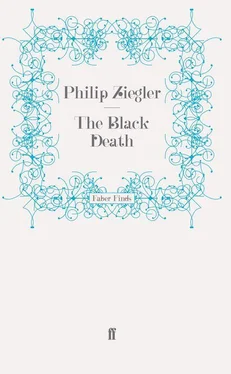The most grave consequence was a series of disastrous harvests. There were famines in England in 1272, 1277, 1283, 1292 and 1311. {52} 52 9. M. Postan, Camb. Econ. Hist., Vol. I, 2nd Edition, 1966, p. 565.
Between 1315 and 1319 came a crescendo of calamity. Almost every country in Europe lost virtually the whole of one harvest, often of two or three. The lack of sun hindered the production of salt by evaporation and thus made still more difficult the conservation of what meat there was. Even if there had been food to store, facilities for storage did not exist. In England wheat more than doubled in price. Cannibalism was a commonplace; the poor ate dogs, wrote one chronicler, cats, the dung of doves, even their own children. {53} 53 10. H. S. Lucas, ‘The Great European Famine of 1315, 1316 and 1317’, Speculum, Vol. 5, 1930, p.355.
Ten per cent of the population of Ypres died of starvation. {54} 54 11. H. Pirenne, Economic and Social History of Mediaeval Europe, 1936, p. 193.
Nor was this the end: 1332 was another disastrous year for the crops and the period between 1345 and 1348 would have seemed uniquely unfortunate in any other century.
Before the Black Death, therefore, much of Europe was in recession or, at the very least, had ceased to advance. Colonization stopped even where fresh fields lay open for the conquest. The Drang nach Osten petered out at the frontiers of Lithuania and Latvia. The cloth trade of Flanders and Brabant stagnated. The great fairs of the Champagne, indices of the economic health of a large and flourishing region, significantly declined. {55} 55 12. L. Genicot, op. cit., p. 673.
The prices of agricultural produce were falling: agriculture was no longer the easy road to prosperity which it had been for the past two hundred years. Put in the simplest terms, Europe had outgrown its strength and was now suffering the physical and mental malaise which inevitably follows so intemperate a progress.
To what extent this recession was reflected in a drop in the population can only be guessed at. Famines on the scale which Europe had endured must at least have checked the hectic growth of the previous two centuries. The retreat from marginal lands which had already set in by 1320 or 1330 in Haute Provence, the Massif Central, Germany west of the Vistula and certain areas of England suggests that in these areas at least a decline must have begun long before the impact of the Black Death. {56} 56 13. ibid, p.666, M. Postan, ‘Some Economic Evidence of Declining Population in the Later Middle Ages’, Econ. Hist. Rev., 2nd Ser., Vol II, 1950, p. 221.
But there is little or no evidence of serious depopulation and no reason to doubt that the hungry mouths in almost every major population centre of Europe must still have been far too numerous for the exiguous supply of food. This disproportion was aggravated by the turmoil to which wars and civil disorders reduced great areas of France, Spain and Italy. The direct cost in human lives may not have been enormous but the destruction of crops and houses and the disruption of the life of the countryside seriously reduced production at a time when a larger food supply was as necessary as ever.
At the middle of the fourteenth century, therefore, chronic over-population was rendering intolerable the existence of many, if not a majority of Europeans. It is tempting to take a step further and see the Black Death as nature’s answer to the problem of over-population, a Malthusian check to the over-exuberance of the preceding centuries. Reviewing a book by Georges Duby, {57} 57 14 L’économie rurale et la vie des campagnes dans l’Occident médiéval, Paris, 1962.
Professor Postan remarked that he had ‘been especially gratified to read the passages in the book wherein the depression of the fourteenth century is represented as the consequence, perhaps even the nemesis, of the inordinate expansion of the preceding epoch’. {58} 58 15 Econ. Hist. Rev., 2nd Ser., Vol. XVI, 1963, p. 197.
Viewed in this light, the Black Death is the nemesis that met a population which bred too fast for too long without first providing itself with the resources needed for such extravagance. Slicher Van Bath attributed the high death rate of the Black Death largely to the prolonged malnutrition which was the consequence of over-rapid growth. {59} 59 16 B. H. Slicher van Bath, Agrarian History of Western Europe, New York, 1963, p. 84.
If there had been no plague, the argument goes, then the population would, in the course of nature, have had to be reduced by other means.
But this line of reasoning should not be pushed too far. For one thing it is by no means universally accepted that medieval agriculture was incapable of supporting the population of the period. Certain authorities, indeed, claim that it could have fed many more without undue strain. {60} 60 17 e.g. R. Delatouche, ‘Agriculture médiévale et population’, Études Sociales, 1955, pp. 13–23.
If there was no need in nature for the population to be reduced, then the Malthusian argument obviously falls to the ground. And even if it were accepted that Europe’s population had outgrown its food supply by the middle of the fourteenth century it is still difficult to explain why the population should have continued to fall for a further fifty years or more. The check had worked, the hungry mouths were in the grave, even the most fanatic Malthusian would hardly have pleaded that the process should be continued.
Elizabeth Carpentier has summed up the controversy with her accustomed lucidity. ‘Was the Black Death,’ she asks, ‘an evil made necessary by inescapable evolution? Or was it a tragic accident at variance with the normal advance of events?’ {61} 61 18 E. Carpentier, ‘Autour de la Peste Noire’, Annales, E.S.C., Vol. XVII, 1962, p. 1092.
But to define a question satisfactorily is not necessarily to arrive at any answer; indeed, in medieval history, it sometimes seems that the more precisely a question is defined, the more certain it is that no answer will be forthcoming. Certainly in this case no clear-cut solution has been, or ever will be attained. All that can be said with confidence is that, in many parts of Europe, in the twelfth and thirteenth centuries, the population had grown with unusual speed; that this growth was a factor of importance, though by no means the only factor, which led to general malnutrition; that malnutrition was a contributory reason for the high death rate of the plague years; and that, as a result of the plague, the population was reduced to more easily manageable proportions. This humble conclusion leaves open many impassioning problems of what was cause and what effect; what blind chance and what the inexorable march of nature. It should be of comfort to future generations of historians to know that such problems exist and sobering for us to reflect that, even though we may triumphantly close the dossier with a decisive answer, our sons and grandsons will quickly have it open once again.
* * *
Whatever one’s thesis about the inevitability of the Black Death it cannot be denied that it found awaiting it in Europe a population singularly ill-equipped to resist. Distracted by wars, weakened by malnutrition, exhausted by his struggle to win a living from his inadequate portion of ever less fertile land, the medieval peasant was ready to succumb even before the blow had fallen. But it was not only physically that he provided an easy prey; intellectually and emotionally he was prepared for disaster and ready to accept if not actually to welcome it.
Though the Europeans of the fourteenth century were painfully aware that they understood little of the disease which was destroying them they were at least confident that they knew the prime cause of their suffering. Few contemporary chroniclers fail to point out that the plague was an affliction laid on them by the Almighty, retribution for the wickedness of the present generation. Konrade of Megenberg, in his refreshingly heretical Buch der Natur , {62} 62 19 ed. Pfeiffer, Berlin, 1870.
was virtually unique in dismissing the theory of divine punishment on the grounds that nothing so promiscuous in its results could possibly have been intended by God.
Читать дальше












